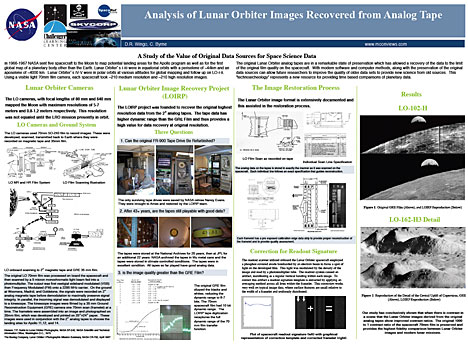Click on image for PDF version of poster
A Study of the Value of Original Data Sources for Space Science Data – Poster presented at the 42nd Lunar and Planetary Science Conference by Dennis Wingo and Charles Byrne.
“In 1966-1967 NASA sent five spacecraft to the Moon to map potential landing areas for the Apollo program as well as for the first global map of a planetary body other than the Earth. Lunar Orbiter’s I-III were in equatorial orbits with a periselene of ~44km and an aposelene of ~4000 km. Lunar Orbiter’s IV-V were in polar orbits at various altitudes for global mapping and follow up on LO-I-II. Using a visible light 70mm film camera, each spacecraft took ~210 medium resolution and ~210 high resolution images. The original Lunar Orbiter analog tapes are in a remarkable state of preservation which has allowed a recovery of the data to the limit of the original film quality on the spacecraft. With modern software and computer methods, along with the preservation of the original data sources can allow future researchers to improve the quality of older data sets to provide new science from old sources. This “technoarcheology” represents a new resource for providing time based comparisons of planetary data.”

